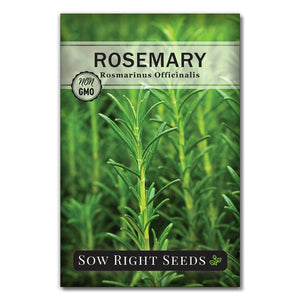How to Grow Rosemary From Seed: 3 Tips for a Healthy Harvest
Herb growing tipsGrowing rosemary from seed is easy to do once you know what this popular herb needs. In this article, we’ll share our three tips for successfully growing rosemary. Once you know how to improve germination rates, mimic the Mediterranean growing climate, and harvest rosemary the right way, you’ll love growing rosemary from seed.

Quick Links
A brief history of rosemary
Rosemary has a rich history of being used for medicinal purposes. Its fragrance was valued for stimulating memory and increasing alertness. For this reason, ancient Greeks put rosemary sprigs in their hair while they studied for exams.
Maybe it was while sprigs were in their hair that they discovered rosemary was also helpful for stimulating hair growth.
Other traditional uses for rosemary were to relieve muscle aches and spasms and improve circulation.
Rosemary is one of my favorite herbs to have growing in my garden. I love adding fresh rosemary to sourdough bread, baked chicken, and many other recipes.

Rosemary Seed Germination Tips
Rosemary gets a bad rap for being hard to grow from seed. But that’s only because it needs an extra wake-up call to get growing.
By using simple methods for breaking seed dormancy, you will notice increased germination rates for rosemary seeds.
The simplest method is to soak rosemary seeds before planting. Place seeds in a cup of water and allow them to sit overnight.
Another helpful method is cold stratification. This involves placing the seeds in a moist, cold environment for 4 weeks. We explain this method in detail in this blog on cold stratification.
And another method to try is winter sowing. While a simple method, winter sowing requires planning ahead so you can take advantage of the cold weather.
After soaking or using cold stratification, rosemary seeds will be ready for planting.
You can start rosemary seeds indoors 10 to 12 weeks before the last frost date. However, since rosemary plants take about a year to fully mature, you might want to start seeds even earlier and allow seedlings extra time to grow indoors before transplanting them after the last spring frost.

Planting Rosemary Seeds
- Soak seeds overnight or cold stratify.
- Use moist seed starting mix.
- Gently press the rosemary seeds into the growing medium. Rosemary seeds require light for germination, so don’t cover them with soil.
- Keep the seeds moist. Covering with a humidity dome or plastic will help keep in moisture.
- Provide supplemental heat. Use a heating mat to keep the soil temperature at 65º to 70º F.
- Sufficient lighting. Place lights close to the seeds so they receive enough light to sprout.
- Rosemary seed germination can take anywhere from 15 to 24 days.

Rosemary seedlings are ready to transplant outdoors when the plants reach 3” and all danger of frost has passed.
Before transplanting, acclimate rosemary seedlings to outdoor life by hardening them off. By gradually increasing the time plants spend outdoors, you can avoid transplant shock and promote healthy growth.
When placing plants outside, space them about 18 to 20 inches apart in full sun.

How to Grow Rosemary Outdoors
Rosemary is a Mediterranean herb that thrives in a warm, dry climate. To grow the best rosemary in your own garden, mimic its natural growing conditions.
The western Mediterranean coasts receive cool ocean currents and receive most of their rainfall in the winter with dry summers.
Here are some simple ways to create your own Mediterranean microclimate.
First, make sure you have a sunny location. Rosemary thrives in the sun.
Next, place plants near rocks and stepping stones. These are natural heat collectors and will radiate heat. This is especially helpful during cooler nights. Growing rosemary near a southeastern-facing wall is another way to give rosemary additional heat and protection.
Make sure you have the right kind of soil. Adding sand, vermiculite, or using a cactus potting mix will give you light, well-draining soil.
Watering is always a crucial element for plants. Rosemary is more often killed by overwatering than underwatering. It is used to dry summers and wet winters. Allow the soil to drain and dry between waterings.
Using mulch is not needed as you don’t want to create too moist of an environment. However, using sand, shells, or pea gravel will allow the soil to dry out while collecting and giving off heat.
Rosemary is a slow grower for the first year. But it can eventually be as large as 6 feet tall if grown in the right conditions.
When temperatures get close to 20ºF, it is time to protect your rosemary plants from freezing. Rosemary is not winter hardy in zones 6 and lower.
The main tip for successfully growing rosemary - don’t overwater!

How to Grow Rosemary in a Container
Rosemary is a perennial in zones 7 to 11 and can grow for many years. But in other locations, it will be necessary to grow rosemary in a container to bring indoors during winter.
To grow rosemary in a container, choose a pot that is large enough for the size of the plant. While rosemary can get quite large, you don’t have to start with the largest pot possible. Rosemary can be potted up as the plant grows.
Choose a pot that drains well and use a sandy mix of potting soil. Mixes made for cacti work well.
Don’t overwater. Ensure the soil drains well and only water when the soil is dry below 1 inch. Brown tips on the leaves mean that it’s getting overwatered and possibly has root rot.
Yellow lower leaves mean the plant is root-bound. If you can’t pot up, then you will need to prune the roots. Gently remove the plant from the pot and trim the roots.
If bringing rosemary in for the winter, first get it acclimated to the climate change by leaving the plant outside during the day and then bring it in at night. Continue doing this for a week or two.
How to Grow Rosemary Indoors
While it isn’t always ideal, rosemary can be grown indoors year-round. How well it grows inside depends on the growing conditions.
To create its optimal microclimate, consider these questions. Can the rosemary plant get moisture from the air? Does the soil drain well and dry out between waterings? Is there plenty of sunshine?
As a native Mediterranean herb, rosemary grows in a location where there is more evaporation than rain. To mimic this, place your pot of rosemary on a tray of stones. Add water to the stones to a depth that doesn’t reach the bottom of the pot. This will allow the leaves to absorb the water as it evaporates while the roots stay dry.
Rosemary plants grown indoors may remain small and less bushy if they don’t receive enough light. If bringing them in from outdoors, they will need time to adjust to less sunshine.
If your indoor rosemary plant is spindly with little side growth, try giving it extended periods of light. Outdoors, rosemary needs 6 to 8 hours of sunshine. Without direct sunlight, it will need extra time with indoor lighting.

How to Harvest Rosemary
Once a rosemary plant is established, you can harvest it anytime. The secret to harvesting the best-tasting rosemary is to cut fresh sprigs before they are woody. These new green leaves are the most flavorful part of the plant.
Rosemary is a sturdy plant, so use sharp garden scissors to make clean cuts without damaging the rest of the plant. And also, never cut off more than 1/3 of the plant at a time.
Rosemary plants can be pruned as they grow and trained into all kinds of shapes, from Christmas tree shapes to creative topiaries. If you don’t need large sprigs, just take small amounts to shape the plant as it grows.

Drying Rosemary
While fresh herbs are always more flavorful than dried, rosemary retains much of its flavor and is easy to dry.
To dry rosemary, cut off full lengths of branches and hang them in a dry place away from sunlight. To help retain its full flavor, wait until you use the dried rosemary to cut or crush it.
The culinary uses for rosemary are endless, from soups to roasting vegetables, grilling with meat, marinades, dips, and so much more. Once you’ve got a healthy rosemary plant in your own herb garden, you’ll find it showing up in all kinds of dishes. And with these germination, growing, and harvesting tips, you’ll soon have an endless supply.

The health benefits of rosemary
While putting rosemary sprigs in our hair to get better grades may not be that effective, rosemary has many proven health benefits.
- Rosemary is a rich source of antioxidants and also has anti-inflammatory properties.
- It is commonly used in aromatherapy, where it has been shown to relieve stress.
- In Germany, rosemary has been approved as a treatment for indigestion.
- Many studies show the health benefits of rosemary; a fairly comprehensive list can be found here.
- And as for putting it in your hair? It turns out there’s evidence that rosemary can improve hair growth.
With all these health benefits, who wouldn’t want to grow rosemary?

Remember the 3 tips for growing rosemary from seed:
Use the right methods to improve germination rates.
Mimic the Mediterranean growing climate.
Harvest rosemary the healthy way for a continual harvest.
If you love the smell and flavor of rosemary, add it to your garden. You'll appreciate its easy-going maintenance.
At Sow Right Seeds, we love helping gardeners have a successful harvest. So let us know how your rosemary grows, and send us a message if you have questions.
Found this information helpful? Share it with your gardening friends!









Leave a comment